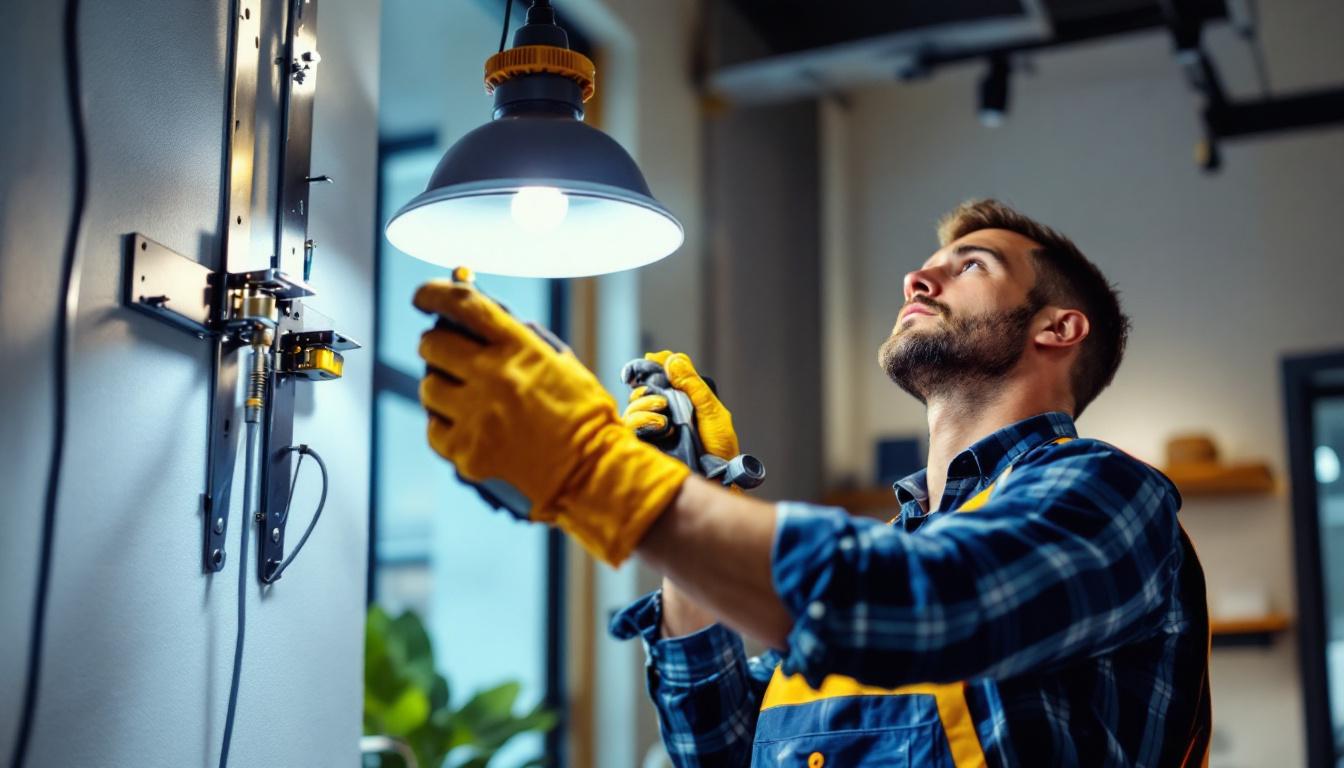
In the realm of lighting installation, the significance of mounting brackets cannot be overstated. These essential components serve as the backbone for securing light fixtures in both residential and commercial settings. For lighting contractors, mastering the art of selecting and installing mounting brackets is crucial for ensuring safety, functionality, and aesthetic appeal. This article delves into the various aspects of mounting brackets, offering valuable insights and resources for lighting professionals.
Mounting brackets are designed to provide a stable foundation for light fixtures, allowing them to be securely attached to walls, ceilings, or other surfaces. They come in various shapes, sizes, and materials, each tailored to specific types of fixtures and installation environments. Understanding the different types of mounting brackets and their applications is the first step toward successful lighting installations.
There are several types of mounting brackets available, each serving distinct purposes. The most common types include:
Choosing the right type of bracket is essential for ensuring the fixture’s longevity and performance. Each type has its own set of installation requirements and load capacities, which should be carefully considered before making a selection. For instance, when selecting adjustable brackets, it’s crucial to assess the weight of the fixture and the desired angle of illumination, as this will impact the overall effectiveness of the lighting setup. Moreover, ensuring that the bracket aligns with the electrical box in the wall or ceiling can prevent future complications during installation.
The material of a mounting bracket plays a significant role in its durability and suitability for different environments. Common materials include:
Understanding the properties of these materials helps contractors make informed decisions based on the specific needs of each project. For example, in coastal areas where saltwater can accelerate corrosion, opting for stainless steel or powder-coated aluminum brackets can enhance the longevity of the installation. Additionally, the choice of material can also affect the aesthetic appeal of the fixture; sleek aluminum brackets may complement modern designs, while robust steel options may suit industrial-style lighting. Furthermore, the environmental impact of materials is becoming increasingly important, prompting many manufacturers to explore eco-friendly options that do not compromise on strength or durability.
Proper installation of mounting brackets is critical to the overall success of a lighting project. Following best practices not only enhances the safety and functionality of the fixtures but also contributes to the aesthetic appeal of the installation. A well-executed installation can transform a space, creating an inviting atmosphere while ensuring that the lighting serves its intended purpose effectively.
Before beginning the installation process, it is essential to gather the necessary tools. Common tools include:
Having the right tools on hand can streamline the installation process and help avoid potential issues down the line. Additionally, it might be beneficial to have safety gear such as goggles and gloves, especially when working at heights or with power tools. This not only protects the installer but also ensures that the installation is carried out with the utmost care and professionalism.
To ensure a successful installation, follow this step-by-step guide:
By adhering to these steps, contractors can ensure a secure and reliable installation that meets industry standards. It’s also important to double-check the wiring connections before powering on the fixture. Ensuring that all electrical components are correctly installed not only guarantees functionality but also minimizes the risk of electrical hazards. Furthermore, consider the type of bulbs being used; LED options can provide energy efficiency and longevity, enhancing the overall effectiveness of the lighting solution.
Safety should always be a top priority when working with electrical installations. Understanding the safety considerations associated with mounting brackets is vital for lighting contractors.
Each mounting bracket comes with a specified weight capacity, which should never be exceeded. It is essential to check the load ratings of both the bracket and the light fixture to ensure compatibility. Overloading a bracket can lead to fixture failure, posing safety hazards. Furthermore, it is important to consider the type of environment in which the fixture will be installed. For instance, outdoor installations may require brackets that are specifically designed to withstand weather elements, while indoor installations might prioritize aesthetics alongside functionality. Always refer to the manufacturer’s guidelines for specific recommendations on weight limits and environmental considerations.
Before beginning any installation, it is crucial to turn off the power supply to the circuit where the fixture will be installed. This precaution helps prevent electrical shocks and ensures the safety of the contractor during the installation process. Additionally, using insulated tools can further reduce the risk of electrical accidents. It is also advisable to wear personal protective equipment (PPE), such as rubber gloves and safety goggles, to provide an extra layer of protection. Contractors should familiarize themselves with the layout of the electrical system, including the locations of circuit breakers and fuses, to quickly address any potential issues that may arise during installation. Regularly inspecting tools and equipment for wear and tear can also help maintain a safe working environment, ensuring that all installations are completed without incident.
Even experienced lighting contractors may encounter challenges during the installation of mounting brackets. Understanding these common issues and their solutions can enhance efficiency and effectiveness.
One of the most common challenges is dealing with uneven surfaces, which can affect the alignment of the fixture. To address this issue, adjustable mounting brackets can be used to compensate for variations in the surface. Additionally, shims can be employed to level the bracket before securing it in place.
In situations where space is limited, finding a suitable mounting location can be difficult. In such cases, opting for compact or low-profile mounting brackets can help maximize the available space while still providing adequate support for the fixture.
To further enhance their skills and knowledge, lighting contractors can access a variety of resources dedicated to mounting brackets and lighting installation.
Many industry organizations and manufacturers offer online training programs and webinars focused on lighting installation techniques, including the use of mounting brackets. These resources provide valuable insights and updates on the latest trends and technologies in the field.
Consulting manufacturer guidelines and specifications is crucial for understanding the proper installation techniques and requirements for specific fixtures and brackets. These documents often contain essential information about load capacities, installation procedures, and safety precautions.
The lighting industry is continually evolving, and advancements in mounting bracket technology are no exception. Staying informed about these innovations can give contractors a competitive edge.
With the rise of smart lighting systems, manufacturers are developing smart mounting solutions that integrate with home automation systems. These innovative brackets can simplify the installation process and enhance the functionality of lighting fixtures, allowing for remote control and customization.
As sustainability becomes increasingly important, many manufacturers are exploring eco-friendly materials for mounting brackets. These materials not only reduce environmental impact but also offer durability and performance comparable to traditional options.
Mastering the use of mounting brackets for light fixtures is an essential skill for lighting contractors. By understanding the different types of brackets, installation best practices, safety considerations, and common challenges, contractors can enhance their expertise and deliver high-quality installations. Furthermore, leveraging available resources and staying updated on industry innovations can contribute to ongoing professional development. Ultimately, a solid understanding of mounting brackets will lead to safer, more efficient, and aesthetically pleasing lighting solutions.
Ready to elevate your lighting installations with the highest quality mounting brackets and fixtures? Look no further than LumenWholesale, where we offer an extensive selection of spec-grade lighting products at unbeatable wholesale prices. Say goodbye to middleman markups and hello to reliable, high-performance lighting that meets the most rigorous industry standards. Plus, with free shipping on bulk orders, you can stock up on premium lighting solutions without worrying about hidden fees. Don’t compromise on quality, affordability, or convenience. Discover the best value in wholesale lighting today and light up your projects with confidence.

Discover how lighting baseball fields can boost efficiency for contractors, enhance player performance, and create a safer environment.

Discover the innovative strategies lighting contractors use with Type B lamps to enhance energy efficiency and smart home integration.

Discover essential tips for selecting the right sensor for outdoor lighting projects and learn how to avoid common pitfalls that can lead to costly mistakes.

Discover the allure and practicality of antique solar lamps in modern lighting design.